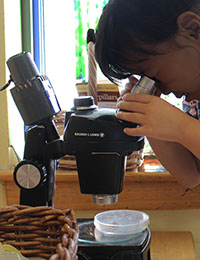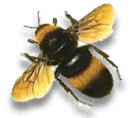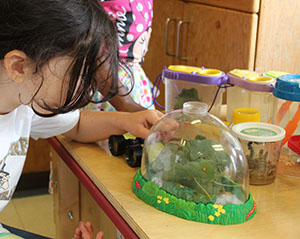
| Home | Week 1 | Week 2 | Week 3 | Week 4 | Week 5 | Week 6 | |
|---|---|---|---|---|---|---|---|
Teacher's Corner
Week 3 Lesson Plan
Here is a sampling of Maryland State standards met:
CCSS.ELA-Literacy.RF.K.3.a
Demonstrate basic knowledge of one-to-one letter-sound correspondences by producing the primary sound or many of the most frequent sounds for each consonant.
During journal time campers are encouraged to sound out words and to label their drawings. Teachers help with this by slowly saying each sound and asking the child what they hear.
CCSS.ELA-Literacy.RF.K.2.e Add or substitute individual sounds in simple, one-syllable words to make new words
The class works to make rhymes from words in the songs they sing such as net- wet or pool- tool in the song "Poor Little Bug on the Wall".
CCSS.Math.Content.K.CC.C.6
Identify whether the number of objects in one group is greater than, less than, or equal to the number of objects in another group, e.g., by using matching and counting strategies.
Arthropods were identified by how many legs they have. Children sorted and discussed the differences in the groups.

CCSS.Math.Content.K.G.B.5 Model shapes in the world by building shapes from components (e.g., sticks and clay balls) and drawing shapes.
Using Unit blocks, magnetic shapes and other materials during free play, children learn to create and mimic shapes and designs in the real world.
Science- 1A1b Seek information through reading, observation, exploration, and investigations.
Throughout this whole study, children have been exploring and investigating the study topic.
Biology- 3E1b Describe ways that people and other animals manage to bring the things they need from their environment into their bodies.
Learning about pollination allowed children to see ways different bees get their food using their proboscis and how they put it near their eggs for the larvae to feed on as they grow.
Physical Education- 1A1c-Demonstrate non-locomotor skills of bending, pulling, stretching, twisting, turning, pushing, and swinging.
Once a week children have yoga with Ms. Bowman. She is collaborating with the children to do poses inspired by insects.

Week 3

What is a bug?  The word Arthropod was introduced and a game helping to divide that group of animals with exoskeletons was played. This game was invented by Ms. Diaz and was taken from information in the book Everything you Ever Wanted to Know About Bugs, by the Smithsonian. Children played by placing a rubber animal replica on the correct circle. The circles represented the quantity of legs each "bug" or arthropod had and included, insects, arachnids, crustations, and myriapods(or centipedes and millipedes). There was also a circle for 0 legs or worms and slugs. These squishy animals did not belong to the group arthropod.
The word Arthropod was introduced and a game helping to divide that group of animals with exoskeletons was played. This game was invented by Ms. Diaz and was taken from information in the book Everything you Ever Wanted to Know About Bugs, by the Smithsonian. Children played by placing a rubber animal replica on the correct circle. The circles represented the quantity of legs each "bug" or arthropod had and included, insects, arachnids, crustations, and myriapods(or centipedes and millipedes). There was also a circle for 0 legs or worms and slugs. These squishy animals did not belong to the group arthropod.
The following day narrowed the topic to insects. A diagram was labeled with the three body part, head, thorax, abdomen and then everyone sang a song to the tune of "Head, Shoulders, Knees, and Toes", but instead it went, "Head, Thorax, Abdomen, 1, 2, 3, 4, 5, 6 legs!"
 Thursday's focus was bees. Children acted out how social bees behave with a queen and workers. Earlier they had made crowns to represent the queen bee. Then they acted out how a solitary bee lives by creating a nest in a tube with several layers consisting of an egg, nectar, and finally mud. This was repeated several times. Then everyone walked over to the UMD apiary to view a living solitary bee nest and to observe the actual layering of eggs in long wood tunnels. Some children thought they say bees going into the nest. The campers checked for other insects and bugs in the gardens of the apiary. There was a lot of excitement when slugs, beetles, and grubs were found. Honey was served as snack that day.
Thursday's focus was bees. Children acted out how social bees behave with a queen and workers. Earlier they had made crowns to represent the queen bee. Then they acted out how a solitary bee lives by creating a nest in a tube with several layers consisting of an egg, nectar, and finally mud. This was repeated several times. Then everyone walked over to the UMD apiary to view a living solitary bee nest and to observe the actual layering of eggs in long wood tunnels. Some children thought they say bees going into the nest. The campers checked for other insects and bugs in the gardens of the apiary. There was a lot of excitement when slugs, beetles, and grubs were found. Honey was served as snack that day.
After learning about pollination and acting it out during meeting with flowers and talcum powder as pollen, the children found a row of lilies that they could gently stick their fingers in to coat with pollen. The children acted as bees and spread the pollen to the next flower. One girl wanted to spread lily pollen to a Blackeyed Susan, that's another lesson! Children chatted about wether they would like to be a social bee or a solitary bee. Two friends agreed they wanted to be social bees.
 A local beekeeper, James Garvin, gave the Yellow room a loan of some of his tools. The children were able to try on Garvin's son's bee suit, which was small and press the bellows on a real smoker, which they learned calmed the bees. They were also able to feel the wax and touch one of the bee supers(hive) to see how the frames fit in. To supplement this activity excerpts from Gail Gibbon's book The Honey Makers were read.
A local beekeeper, James Garvin, gave the Yellow room a loan of some of his tools. The children were able to try on Garvin's son's bee suit, which was small and press the bellows on a real smoker, which they learned calmed the bees. They were also able to feel the wax and touch one of the bee supers(hive) to see how the frames fit in. To supplement this activity excerpts from Gail Gibbon's book The Honey Makers were read.
After noticing the children were seldom using their journals teachers started giving writing prompts for their journal writing just before rest time. The first was to draw an insect with it's three body parts. Another was to answer the question, "If you were a bug what kind would you be?" At this age most children are just learning to sound out letters so the teacher wrote the words for those that asked.
 The teachers of the Yellow room bought lady bug larva and Painted Lady caterpillars to observe in the classroom. It was noticed that some of the caterpillars had started to form chrysalises on Friday. This was a delema since the directions that came with them said they needed to be put in the net container once this happens to all of them.
The teachers of the Yellow room bought lady bug larva and Painted Lady caterpillars to observe in the classroom. It was noticed that some of the caterpillars had started to form chrysalises on Friday. This was a delema since the directions that came with them said they needed to be put in the net container once this happens to all of them.  One girl, who had experience with raising the painted ladies, suggested the teacher take them home to do the transfer if needed.
One girl, who had experience with raising the painted ladies, suggested the teacher take them home to do the transfer if needed.
The ladybug larvae seemed to be disappearing. We had received about 15 when they arrived from the supplier but the children noticed only a few were in the habitat this week. Another girl had been observing ladybugs in various stages on a particular tree on the playground. She went with the teacher and collected some to replenish the missing larvae.
A journal is kept near the insects for children and teachers to write or draw observations in. Campers continue to bring in interesting bugs from home to share with their classmates during meeting time. This boy had a lightening bug he had caught.